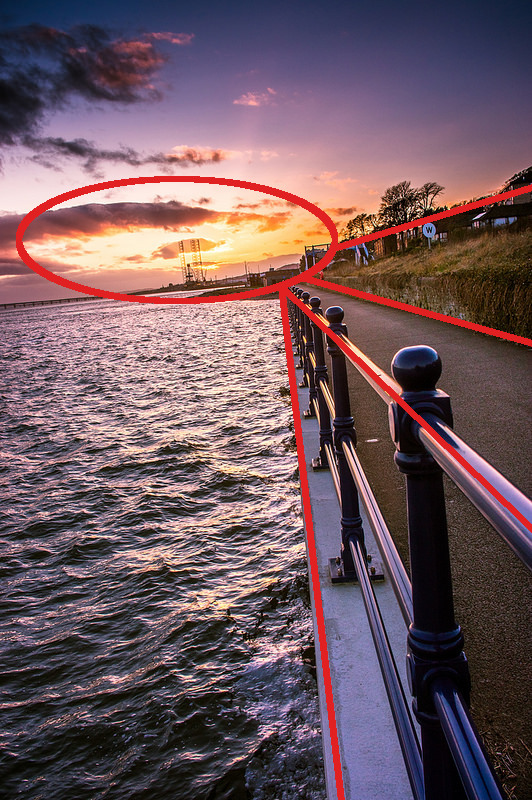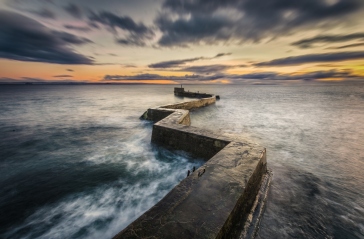Often within a photograph you will want the viewer’s eye to be drawn towards certain elements within the image such as a main focal point, or drawn away from distracting elements which do not add to the image. Although there are numerous compositional tricks to achieve this, one of the most commonly used is Leading Lines.
What are Leading Lines?
Leading lines are basically elements within an image which form visual lines that lead the viewers eye through the image, or to certain points within an image. These lines are visually prominent with the image and the viewers eye is almost uncontrollably drawn towards and along them. Because of this, they are a powerful element in the composition of an image.
Here is a straightforward example of them in use. The image below shows a sunburst on the horizon which forms the focal point of the image. The path and rails form visually prominent lines which the viewer’s eye is drawn towards and it leads their eye along these towards the main point of the sunburst.

I have illustrated this below by encircling the focal point, which is the sunburst, and highlighting the leading lines.

How are they Achieved?
For leading lines to be effective these have to be visually prominent with an image i.e. they have to catch the eye. Basically, their visual prominence is achieved through contrast with elements surrounding them. This contrast can be achieved in a number of ways which I have listed below.
Luminosity Contrast
Leading lines will stand out more if they have markedly different luminosity from their surroundings. The example below shows this. The focal point is the mountain, the two leading lines are the crest of the wave and the branch which have significantly different luminosity than the surrounding water. I have shown this in b+w to show more clearly the luminosity difference.
Colour Contrast
Complimentary colours which are at opposite sides of the colour wheel will contrast more heavily than analogous colours which are next to each other in the colour wheel. In the example below, the orange of the trees contrasts heavily with the blue of the water as they are opposite each other in the colour wheel. These then forms visual lines which lead the eye towards the focal point which is the building.
Colour contrast can also be achieved through saturation contrast. Heavily saturated colours will contrast with desaturated colours. In the example below the heavily saturated colours of the rainbow contrast with the grey of the sky, leading the eye through the photo toward the copse of trees.
Sharpness Contrast
Sharp elements within an image contrast heavily with soft or out of focus elements within an image. The example below was a 55 sec exposure which blurred the water making the rock formations more visually prominent.
Straight or Not?
The term leading ‘line’ suggests an element of straightness to it but it is just as effective when it’s a bit curvy or zig-zaggy as shown below.
You can even have fragmented lines as shown in the example below.
Where does it Lead to?
Now that I have had a look at what leading lines are and how to achieve them within an image, I now want to look at how to use them as a compositional element within an image.
Leading to a Focal Point
This is probably the most common use for leading lines, where they lead your eye towards the focal point of an image. It is a powerful technique that really draws the eye heavily towards the focal point, which should already be the most prominent element in the composition.
Here is a good example below. The focal point is the monument on the hill which is tiny in the photo but the leading lines of the path draw your eye straight to it making it pop from the image.

Most of the other images above also lead the eye towards a prominent focal point.
Leading through an Image
Where there is no definite focal point, leading lines can be used to guide your eye through an image. This can help to guard against areas of dead space within an image and provide a more complete scene which fills the area of the photo.
The example below shows this with the cable and pipeline leading your eye from bottom to top through the image.

In the next image I have (crudely) removed these elements to show the difference it makes. It now feels like the area in the top right of the photo is just dead, unused space and the composition feels too weighted towards the bottom of the photo.

Here is another example where the blurred, white water guides the eye through the image.

Leading to Visual Balance
Leading lines can be used to create an element of visual balance within an image. If a composition is weighted heavily to one side of an image, adding a leading line going in the opposite direction to this can help provide visual balance.
A good example of this is the misty pipeline shown above. However, here is a more extreme example below. The silhouetted rig in the top right of the photo is a visually prominent element however it is way over on the right of the image. I have visually balanced this by adding a strong leading line going to a similar point on the left of the image. Although the composition may look slightly bizarre it does have a strong visual balance within it.

Leading away from Distraction
I have hopefully shown how leading lines can be used to draw the viewers through the image and towards certain areas in the photo. However, it can also be a handy tool to draw the eye away from elements within the photo which serve only as a distraction. This is a handy trick in landscape photography as you will often end up with unwanted elements that cannot be moved or removed at the time of shooting.
The image below is a good example of this. The focal point is the ornate, arched bridge. By including leading lines going towards it, it not only draws the eye towards the bridge but also draws it away from the multitude of distracting elements such as lampposts, trees and windows.

Conclusion
I hope this post has been helpful in showing the uses of leading lines in photographic compositions. So next time your are out and about snapping away, have a look for all the ‘lines’ you can see and think about how you can use them to enhance the compositions of your photos.
Thanks for Reading,
Neil
























